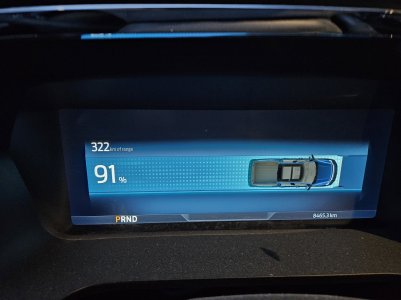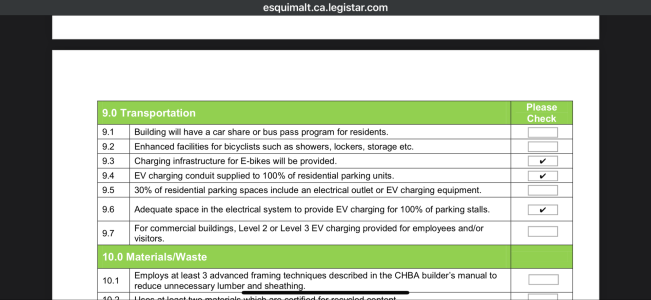@kaelc - I have a bit of experience with EV charging in new multi-family apartment stratas - forgive me if I get a bit too far into the weeds. I see three main issues:
1) Common Property vs Limited Common Property. In 99% of all stratas your parking stall is designated as 'limited common property' on the strata plan (sometimes its done as an exclusive use license, but the impact is similar). What that means is that although the parking stall is not a part of your strata lot, it is common property assigned to the exclusive use of that strata lot. It basically means you are as close to owning it as you can get. The flip side of 'you own it' is that you don't share it. Lets say the strata wants to install a few EV chargers for use by all owners - there's just nowhere to do it because everyone owns their own stall there is no mechanism to share. As such, the only option is to install an EV charger (or allow sufficient capacity) at every single stall.
2) Electrical Capacity. In a single family house you typically have a 100amp or 200amp electrical service and power transformation to 120/240V is handled by the utility. The electrical load on your panel is a relatively simple calculation that takes floor area + electric range + electric dryer + Electric heating/cooling, and de-rates the load for each of these because they typically do not occur simultaneously. Load from an EV charger is not de-rated, and adds 30-50amps on top. In an apartment building, you do a similar load calc, however as the number of units increases the Electrical code allows you to further derate the main electrical service because not all loads from all suites occur simultaneously. However, EV load is on its own dedicated electrical system which is completely seperate from the suites and the Electrical code does not allow you to de-rate these loads (eg it requires the entire EV system to be sized in order to handle every single EV charging simultaneously). It is not uncommon to see the electrical system for the EV charging system sized almost the same as the entire rest of the building. Essentially you end up with an EV charging electrical system so big, that the building needs a second unit substation (the main transformer that received power from the utility ar 12,500/25,000 volts). To avoid this, the only real option is to rough-in a 'load management' system in which central load management hardware/software monitors the loads going to the chargers and then throttles capacity up or down based on which EVs are actually charging while not exceeding the building's electrical system capacity. In these 'networked' systems, a single 40amp circuit can handle up to 4 stalls, versus 1-40amp circuit per stall with a conventional charger. The main problem with these systems is that they operate on 3rd party subscription software, use proprietarty hardware, and have high monthly subscription costs. The developer can rough in the wiring/panels for these systems, but they can't install the load management system or the actual chargers because you would be committing to a particular system and every strata owner would now be paying for the EV charging load management service whether they own an EV or not. As of right now, most apartment buildings only have a few EVs.
3) Billing. In a modern strata building, BC Hydro will supply a dedicated/shared master meter for the exclusive use of the EV charging system. They won't supply individual meters to each EV charger, and the BC Utility Commission does not allow the strata to use the meter's built in software to track consumption for billing purposes because that would make the strata a 'reseller' of electricity and the EV chargers are not utility grade meters. As such, the strata gets one bill for EV charging and the only way to apportion it is by dividing it among all EV users as a fixed charge. Given the relatively low cost of electricity for EV charging, that's not a huge issue in practice - but strata's hate it because they have to explain why the person who drives 50km/week is paying the same monthly charge as the guy driving 100km/day. 'Perceived fairness' is a huge issue when it comes to running a functional strata meeting.
Strata corps are run by volunteers and aren't always the most sophisticated operators. Managing the installation/billing of an EV charging network is like running a small utility and is just beyond the scope of most Councils. Consequently, you see a lot of buildings that have been rough-ed in for EV chargers, where the Strata just sits on their hands and does nothing because they don't fully understand what they have, what the limitations of the building are, or who to talk to. Every option requires an expensive commitment, and is extremely hard to do if you only have a handful of initial EV owners.
What I would really like to see is an approach that makes it feasible for the developer to install the finished meters without requiring crazy electrical systems - either with fewer/simpler non-networked meters that are shared (or installed in shared 'common property' parking stalls). Would it be completely crazy in our modern world to have an EV charger shared between 2 stalls, and each person has the right to charge every other day? Alternatively, have the developer just install 1-2 DC fast charging station per building (with utility grade metering and direct credit card billing), and forget the individual Level 2 chargers entirely.



